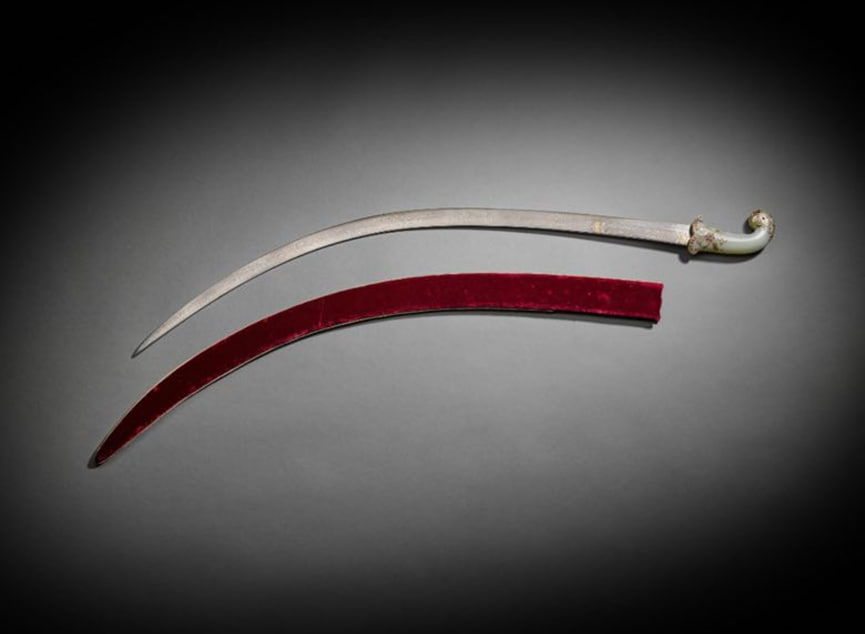The Nawab’s gift, the general’s treasure – the mysterious history of a rare sword
🔴 The Baburid legacy at Sotheby’s auction
🔴 From the Baburid era to Uzbekistan’s treasury
On April 29 of this year, numerous rare swords and daggers belonging to the collection of Philippe Missillier were put up for auction at Sotheby’s in London, United Kingdom. Among them was a sword presented by Asaf-ud-Daula, the Nawab of Awadh and one of the ministers of Shah Alam I, a representative of the Baburid dynasty, to the English army general Claude Martin.

The “pillar of strength” of the Baburid state
The powerful Baburid Empire, founded by the great commander Zahiriddin Muhammad Babur, ruled over most of India for 332 years. Over the centuries, the empire encompassed many provinces, autonomous regions, and semi-independent states. Smaller states under Baburid authority were ruled by local dynasties, whose rulers were typically appointed by the Baburids.
The state of Awadh (Oudh) in northern India was also considered an important part of the Baburid Empire. The ruler (Nawab) of Awadh simultaneously held the position of minister at the Baburid court. One of them, Nawab Asaf-ud-Daula (1748–1797), was among the most prominent officials of the Baburid Empire. After the death of his father, Shuja-ud-Daula, in 1775, he assumed both the position of minister and the title of Nawab.
At that time, the British government was tightening its grip over India through the East India Company. Especially during the reign of Shah Alam II, the empire faced decline both economically and militarily. In such a period, Nawab Asaf-ud-Daula remained a loyal servant of the Baburid ruler.
He contributed significantly to maintaining peace, stability, and security in the country, particularly by managing relations with the British.
Asaf-ud-Daula not only governed Awadh but also initiated a number of reforms across India. Under his patronage, mosques, madrasahs, hospitals, and caravanserais were built in cities such as Faizabad and Lucknow.
The French general in the English army
The East India Company was established in 1600 to strengthen trade with India. However, over the centuries it transformed into a symbol of Britain’s colonial policy. Later, its authority expanded, and with the help of modern military weapons, it began occupying large parts of India.
Among the thousands of English soldiers in India were not only ruthless commanders but also cultured officers with a keen interest in art, culture, and science. One of them was Claude Martin (1735–1800), of French origin. From a young age, he had been fascinated by Eastern history and art.
At that time, the French, too, had developed a strong interest in the East, particularly India, and in 1664 they established their own “Indes Orientales” Company, following the English model. At the age of 16, Claude Martin joined this company and soon departed for India. He served as an officer in the company for nearly ten years. In 1761, the Pondicherry district of India, then under French control, was captured by the English. The French suffered heavy losses in this conflict. Later, Claude Martin enlisted in the French army, marking the beginning of his true career.
At that time, a large contingent of English troops was stationed in the province of Awadh. Local rulers cooperated with them, and English officials made up a significant portion of the court administration.
Claude Martin, with his knowledge, experience, and diligence, caught the attention of Nawab Shuja-ud-Daula. Later, under the order of his successor, Asaf-ud-Daula, he was appointed as the official responsible for the state armory.
Although he was of a different faith and nationality, Claude Martin treated the Baburid Empire with special respect and reverence. Because of his loyalty and services, he was honored with various titles and gifts by both the British government and the Baburids. In 1795, he was granted the rank of Major General by the British military command. He died in Lucknow in 1800.
The general’s priceless treasure
Alongside being a skilled commander, Claude Martin was also an avid collector of antiquities. He maintained constant connections with Indian painters, scholars, poets, and artists. He purchased many works created by Indian painters at high prices for his gallery.
In his palace, he created a private museum where thousands of rare artifacts related to India’s history were preserved. He also maintained a special collection of gifts presented to him by rulers and close friends.
One day, Nawab Asaf-ud-Daula, in recognition of Claude Martin’s services, presented him with a sword adorned with gold, silver, and precious stones. The blade, crafted from high-quality steel, bore an inscription in Persian: “By the order of His Excellency Nawab Asaf-ud-Daula, ruler of Awadh, General Martin of the East India Company is hereby rewarded, year 1201 Hijri”. According to this inscription, the sword was gifted to the general in 1786–1787 CE.
Claude Martin treasured this sword as one of his most valuable gifts until the end of his life. After his death, the rare items in his collection were dispersed across the world through auctions. This particular sword was last acquired at Sotheby’s auction in New York in 1985 for the collection of the renowned collector Philippe Missillier (1942–2002), where it was preserved under inventory number 176C. It was later exhibited in international displays in India and France during 2010–2011.
Now, this rare sword is preserved in the treasury of the Center of Islamic Civilization in Uzbekistan as a priceless gem of the Baburid era.
Rustam Jabborov
P/S: The article may be used with reference to the official website of the Center.
Most read

Over 100 experts from more than 20 countries of the world are in Tashkent!

The Center for Islamic Civilization – a global platform leading towards enlightenment

The museum of the Center for Islamic Civilization in Uzbekistan has been further enriched: unique artifacts from different parts of the world have been presented as gifts











